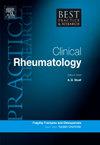Rheumatic manifestations of HIV/AIDS
IF 4.8
2区 医学
Q1 RHEUMATOLOGY
Best Practice & Research in Clinical Rheumatology
Pub Date : 2025-05-01
DOI:10.1016/j.berh.2025.102071
引用次数: 0
Abstract
Rheumatic manifestations of HIV infection encompass a wide spectrum of disorders, arising from direct viral effects, immune dysregulation, opportunistic infections, or antiretroviral therapy (ART)-induced complications. These manifestations can occur at any stage of HIV, and include arthralgia, HIV-associated arthritis, spondyloarthropathies (SpA), inflammatory myopathies, vasculitides, and opportunistic musculoskeletal infections. Arthralgia is common and self-limiting, whereas HIV-associated arthritis mimics rheumatoid arthritis. SpA, particularly reactive arthritis, psoriatic arthritis, and undifferentiated forms, often present atypically in HIV, with pathogenesis linked to immune dysfunction rather than HLA-B27. Inflammatory myopathies, including polymyositis and inclusion body myositis, exhibit distinct clinical features, often necessitating cautious immunomodulatory treatment. Opportunistic infections, such as septic arthritis and pyomyositis, are more frequent with advanced immunosuppression. The advent of HAART has modified the prevalence and presentation of these disorders, with immune reconstitution inflammatory syndrome (IRIS) emerging as a new challenge. Management strategies require balancing disease control with minimizing immunosuppressive risks.
HIV/AIDS的风湿病表现。
艾滋病毒感染的风湿病表现包括广泛的疾病,由直接病毒作用、免疫失调、机会性感染或抗逆转录病毒治疗(ART)引起的并发症引起。这些表现可以发生在HIV的任何阶段,包括关节痛、HIV相关关节炎、脊椎关节病(SpA)、炎症性肌病、血管炎和机会性肌肉骨骼感染。关节痛是常见的和自限性的,而hiv相关的关节炎模仿类风湿关节炎。SpA,特别是反应性关节炎、银屑病关节炎和未分化形式,通常在HIV中表现为非典型性,其发病机制与免疫功能障碍有关,而不是与HLA-B27有关。炎性肌病,包括多发性肌炎和包涵体肌炎,具有明显的临床特征,通常需要谨慎的免疫调节治疗。机会性感染,如脓毒性关节炎和化脓性肌炎,在晚期免疫抑制中更为常见。HAART的出现改变了这些疾病的患病率和表现,免疫重建炎症综合征(IRIS)成为一个新的挑战。管理策略需要平衡疾病控制和最小化免疫抑制风险。
本文章由计算机程序翻译,如有差异,请以英文原文为准。
求助全文
约1分钟内获得全文
求助全文
来源期刊
CiteScore
9.40
自引率
0.00%
发文量
43
审稿时长
27 days
期刊介绍:
Evidence-based updates of best clinical practice across the spectrum of musculoskeletal conditions.
Best Practice & Research: Clinical Rheumatology keeps the clinician or trainee informed of the latest developments and current recommended practice in the rapidly advancing fields of musculoskeletal conditions and science.
The series provides a continuous update of current clinical practice. It is a topical serial publication that covers the spectrum of musculoskeletal conditions in a 4-year cycle. Each topic-based issue contains around 200 pages of practical, evidence-based review articles, which integrate the results from the latest original research with current clinical practice and thinking to provide a continuous update.
Each issue follows a problem-orientated approach that focuses on the key questions to be addressed, clearly defining what is known and not known. The review articles seek to address the clinical issues of diagnosis, treatment and patient management. Management is described in practical terms so that it can be applied to the individual patient. The serial is aimed at the physician in both practice and training.

 求助内容:
求助内容: 应助结果提醒方式:
应助结果提醒方式:


